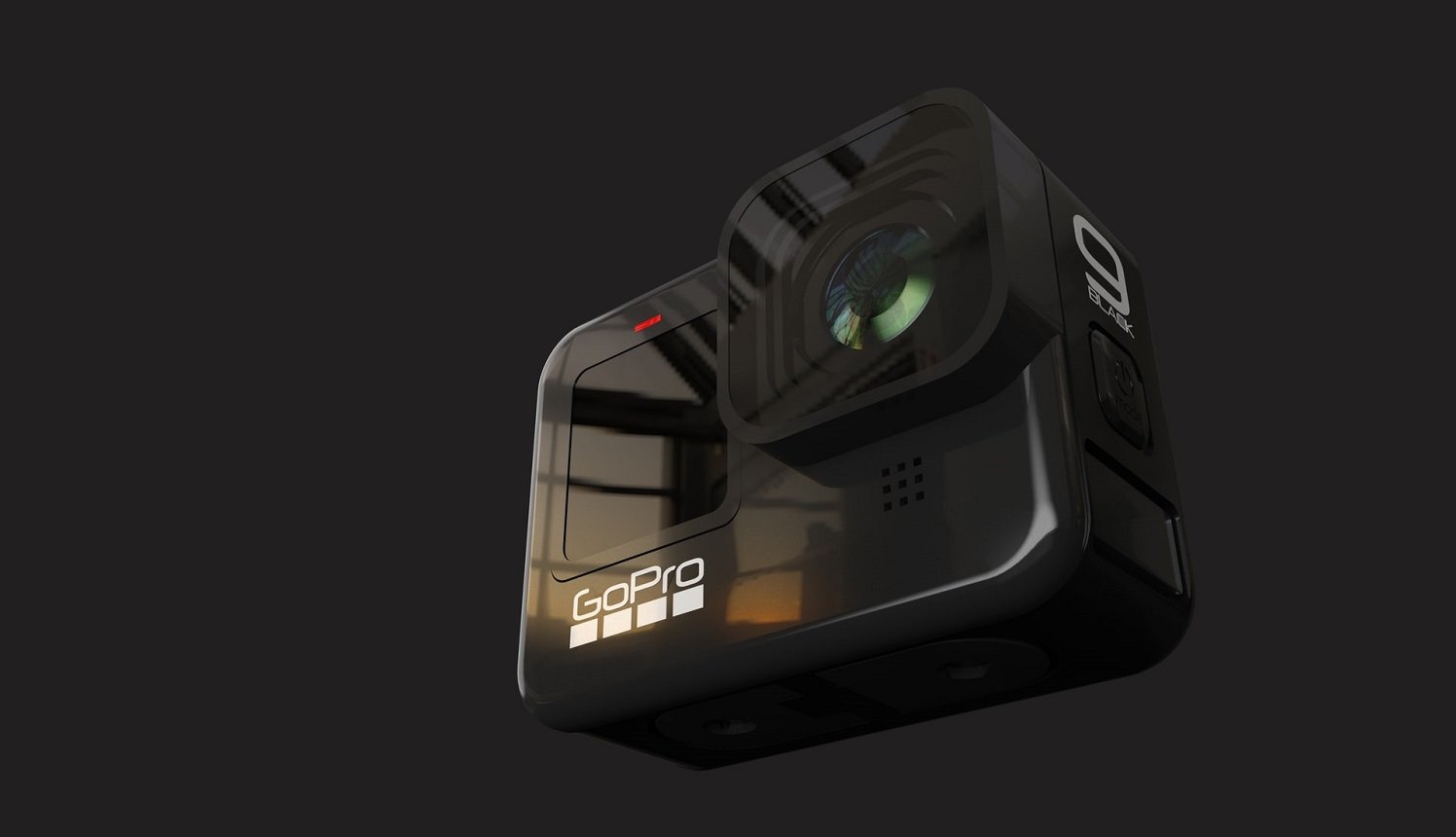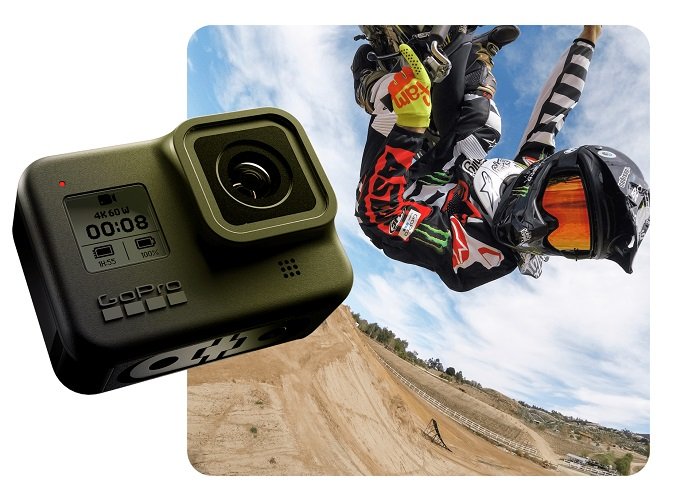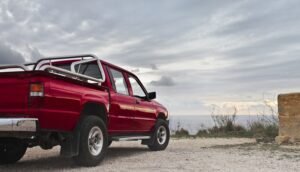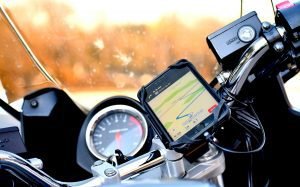Action Cameras for Dirt Biking
Updated on | By Mohit Chauhan

Reader Disclosure
Our editorial content is reader-supported. If you click on some of our links, we may earn a small commission. Learn more here.While the latest smartphones offer impressive picture quality, they cannot be used as a substitute to an action camera. This is because the latter is less sensitive to water and more robust than most cell phones. Consequently, pictures can be taken even in scenarios where the smartphones need to be protected (e.g., in a rainstorm).
Action cams usually have a wide-angle lens that allows a viewing angle of about 180°. And thanks to the extensive range of attachments available, action cameras can even be mounted on handlebars or cross helmets to capture stunning videos and images.
Besides, they incorporate exceptional stabilization, which allows you to dive right into the action and become part of the adventure.
In today’s blog, we’re going to discuss some of the best action cameras that can be used while dirt biking. And of course, like always, we will also showcase an inexpensive alternative. On that note, let’s dive in and take a look.
Best Action Cameras for Dirt Biking

GoPro Hero10 Black
Let’s start with the pioneers of action camera. Yes, you guessed it right, we are talking about the GoPro! Since 2002, the company has been building rugged, waterproof and compact action cameras that can be attached to various surfaces, including your dirt bike helmets, using special mounts.
And despite the fact that their competitors are now offering some pretty amazing action cams, GoPros’ have remained second to none so far.
With the latest model of the Hero10, not much has changed as far as the looks are concerned, apart from the color of the logo. But on the inside, the company made some really big changes.
The new model features a GoPro GP2 processor that doubles the frame rate, something that is very important while dirt biking. In addition, the model offers increased video and photo resolution and comes with an optimized image stabilizer.
Compared to Hero9, the performance has been doubled and the speed of wireless transmission has also been increased by about 30%.
In addition to this, the pre-existing HyperSmooth 3.0 video stabilizer has been revised, and is now called HyperSmooth 4.0 that yields even more smoothness and optimized video quality.
That said, GoPro had already left itself little room for resolution improvements in the 9 series, which already filmed at 5K resolution. Yet, the recent model boasts a 5.3K resolution, and the increase in pure pixel count from 5,120 x 2,880 to 5,312 x 2,988 pixels.
On top of that, GoPro has tweaked almost all frame rates, doubling them in most modes.
Thus, 5.3K recordings now functions at 60 frames per second; whereas only 30fps was available at 5K earlier. Also, at 4K, the camera shoots at 120 frames per second instead of 60, whereas, at 1080p, 240 frames are still possible in slow motion.
Furthermore, the recordings can be slowed down by up to eight times not just at 1080p, but also while shooting at 2.7K.
And despite its numerous features, the GoPro Hero10 is easy to use, even for beginners. Its menu is clearly organized, with short descriptions explaining what is hidden behind the individual menu items.
Moreover, the display responds very quickly to swipe and touch gestures and both the rear and front screens are informative and very easy to read.
But that’s not all, you can install the free GoPro Quik application, that is available on both iOS and Android platforms, to control your GoPro remotely. It also lets you import media content and stream them live in 1080p. In addition, the app also lets you cut movies together, add music or change the playback speed. All in all, it works intuitively and is self-explanatory.
Price: $399

GoPro Hero9 Black
The GoPro Hero10 and Hero9 action cameras are quite similar in appearance, the only difference being the blue logo on the Hero10. Also, both cameras record in 5K resolution, so there is no need to worry about that either. However, the main difference is in the number of frames per second they shoot. So, it all depends on your budget as to which of the two models is more ideal for you.
The Hero9 has GoPro’s first-generation processor. And although it does not reach the high frame rates of the Hero10, you can still film in 5K resolution with this action camera at 30 frames per second.
When it comes to 4K, Hero9 films at 60 frames per second. And if you are recording slow-motion footage, you can do so in 2.7K or Full HD resolution at 120 and 240 frames per second, respectively.
The lens has a resolution of an impressive 20 megapixels, compared to 12 megapixels on the Hero8 Black. This gives entry-level riders the ability to record videos that look absolutely professional.
This increased image resolution of the camera lens makes for an even more stable image and decreases all the unnecessary artifacts due to micromotion.
In addition, there is the TimeWarp 3.0 mode, which allows you to create accelerated and stabilized videos.
And amongst the most innovative features, is the horizon leveling. So, even if your GoPro is not mounted correctly on a mount, it will be able to take perfectly aligned videos thanks to the software processing (this function can be used when recording with “linear” viewing angle).
Furthermore, four angles of view can be chosen: SuperView, Linear, Linear + Horizon Leveling, and Narrow.
Another cool feature is Hindsight, which on enabling, captures 30 seconds of footage before you even press the record button. This ensures that you do not lose the moment you want to capture.
As for photos you have the option of taking photos with a resolution of up to 20 megapixels in raw format. Plus, the sharpness is excellent, and so is the color balance. In fact, these are far better than the images or videos captured by high-end smartphones, owing to the possibility of adjustable capture angles.
Even the audio quality of the built-in microphones is very good. Despite the wind and engine noise, they fare very well in recording the rider’s voice. So, in case you are not a professional vlogger, you won’t be needing an external microphone.
And in case you need one, GoPro also provides MediaMod for Hero9 Black, that features a better-quality microphone, aux jack, and micro-HDMI jack.
GoPro is the king of action cameras, and in our opinion, this Hero9 Black does nothing but strengthen its leadership by increasing the gap between itself and the rival brands. Its dual display, longer duration battery, more effective stabilization, reliable software, and high-resolution videos make it one of the best dirt bike action cameras in the market.
Price: $299

Insta360 ONE R
Until now, 360-degree cameras and action cameras were distinctly separated from each other. However, things have changed with the introduction of Insta360 ONE R.
If you are a professional moto vlogger, you might have to carry a lot of equipment with you. Insta360 offers an ideal solution to this problem: Using the Insta360 ONE R, the company adopts the principle of interchangeable lens cameras on action cameras. All you have to do is simply assemble the camera that you need at the moment.
Founded in 2014, Shenzhen Arashi Vision Co., based in Shenzhen, China, is the mastermind behind the brand Insta360. Starting from entry-level models all the way up to high-end professional versions, there is probably no other manufacturer that offers such a wide range of panoramic view.
The Insta360 ONE R is a modular camera consisting of a battery base (the red unit), the recording and control module (with touchscreen, memory card slot and two control buttons), as well as three different camera modules: a dual-lens 360-degree camera, a standard 4K action camera and an action camera module with a large 1-inch sensor developed in collaboration with Leica.
With the ONE R Twin Edition, the camera can be configured as a 4K action camera using a wide-angle lens, or as a 360-degree camera for all-around shots. And no matter which lens you choose on the unit, the camera will be no bigger than a GoPro.
You can choose to record high-resolution videos in classic 16:9 or 4:3 format, or save the entire panoramic view, depending on the lens you use. Thanks to a straightforward snap-in system, the camera’s different units can be swapped out in seconds.
The ONE R features very good electronic image stabilization and an IPX8-certified housing that is waterproof down to a depth of five meters. Riders who are keen to shoot their videos with splashes of water flying around their dirt bike can now do this owing to its water-resistant properties. In addition, HDR recording (for photos and videos), continuous shooting, time-lapse function, slow motion recording and special night modes are also available.
As far as video quality is concerned, Insta360 delivers a remarkable quality, yet in comparison to the Hero9, some of the results are clearly inferior.
All in all, riders who want to shoot using both an action camera and a 360-degree camera are in for a treat with the Insta360 ONE R. However, those looking for a pure action camera are better off with the GoPro or even the DJI Action 2, which we will discuss shortly.
Price: $299

DJI Action 2
After a long wait, DJI unveiled the successor to its Osmo Action camera. The newly released Action 2 camera drops the Osmo in its name, along with unnecessary weight and the classic design concept of action cameras.
With a weight of just 56 grams and dimensions of 39 x 39 x 22.3 mm, Action 2 is currently the only tiny action camera that can record 4K at 120 fps.
Over the years, we have seen a tremendous evolution in action cameras. Earlier, action cams were very small and lightweight, but were only rugged and waterproof due to a protective housing that was usually included. Subsequent generations were a bit larger, but no longer needed an additional housing for most uses, just a holding frame.
One stage further in the evolution, touchscreens and integrated mounts appeared, but the action cams got bigger and bigger over time. In most cases, the pioneer of action cameras, GoPro, led the way and was subsequently imitated by lesser-known brands.
DJI, on the other hand, has a reputation of being a very innovative company. It is the world market leader in the field of drones and also fares very well in related areas such as electronic gimbals. Not too long ago, DJI launched an action camera in the market, the Osmo Action, which was acclaimed to be the most ideal piece of helmet cameras for motorcyclists. But with its latest release, DJI entered into a full competitive mode with the rival GoPros’.
With Action 2, DJI has addressed the action camera issue for the second time, apparently putting all the existing concepts into a jar and giving them a good stir. And the result turns out to be a camera that has all the features of any action camera that has ever existed.
Action 2 is a full-fledged action cam in miniature format. Unlike the Insta360, this is not just focused on size, but also on high image quality and a wide range of functions. And while Insta360 consists of at least two units, the Action 2, on the other hand, does without the additional attachments.
At the heart of the DJI Action 2 is a camera module with a 155-degree wide-angle lens. This Action 2 is housed in a cube-shaped casing with a 1.76-inch touchscreen on the back and a centrally placed control button on the top.
Thanks to an integrated battery, a microphone, and 32 gigabytes of internal memory, the lightweight camera is ready to go right out of the box without an additional module. And as a true action cam, it is waterproof up to 10 meters without a specialized casing.
Owing to a pixel density of 350 PPI, the small screen features a sharp display and is sufficiently bright even in direct sunlight. And despite the small size, touch operation is pleasingly good.
Moreover, the video quality and stabilization are tremendous as well. Not to forget, the previous model of DJI was already very convincing in terms of picture quality. Besides, this is so far the only model that competes against the Hero10 to offer 120 fps at 4K resolution.
Price: $279

GoPro Hero8 Black
Whether it’s a speedy downhill ride on your dirt bike, a daring jump, or your first ride into the trails to capture spectacular moments, you need an action cam that is as powerful as it is easy to use.
But you don’t necessarily need to purchase the newest models in order to do so. In fact, this is the best way to get a good bang for your buck! Either wait for a couple of years to buy your favorite action cam with a considerable price drop, or get one that is already in the market for a while now.
Yes, we are talking about the GoPro Hero8. This premium model has been in the market for a couple of years now and has truly impressed us with its excellent video quality, a high-performance stability and intuitive usability, including voice control and fast pairing with the smartphone. And since two more high-end versions are already launched post its release, you might find it on sale in many electronic stores near you.
And unlike the Hero7 Black, the Hero8 Black has not only had its technology redesigned, but also its casing. Both the shape as well as the color have undergone a change. So, instead of mouse gray, the new model is available in black.
However, the most obvious difference compared to the previous models is its built-in mounting characteristic: An integrated action cam mount on the underside of the camera, owing to which the camera can be attached to a tripod, helmet or a handlebar without using an additional mount.
The features available for photo and video recordings are the same as those of other action cams. However, its excellent recording quality and high degree of stabilization makes the GoPro Hero 8 Black the best action cam that does not burn a hole in your pocket.
Another outstanding feature is the “Hypersmooth 2.0” image stabilizer, which compensates for camera shake more efficiently and is now available in all video modes, such as UHD/60p and FHD/240p. Moreover, there is a new boost mode that reduces the field of view slightly, while correcting even the most severe jerks efficiently.
And things get really impressive with the new “horizon lock” feature: The GoPro Hero8 Black uses its motion sensor and keeps the image straight even when it rolls over, guaranteeing impressive shots.
In addition to extremely well-stabilized videos with up to 4K resolution at 60 fps, the Hero8 Black makes slow-motion and time-lapse videos as well. For still images there are bursts, a timer and a sequential shooting function to choose from. Also, the voice control feature that is common in all GoPro models is also equipped in the Hero8.
Price: $299

Akaso V50 Elite
Coming to the most economical action camera in our list: The Akaso V50 Elite.
Like all the latest generation models, the Akaso V50 Elite sports camera owes its image quality to 4K technology which allows you to record at up to 60fps. In layman’s terms, this is the technology used by professionals in cinematic cameras, delivering vivid and pleasing images and scenic highlights.
The package includes; the Akaso V50 Elite sports camera, a remote control, two 1350mAh lithium-ion batteries with dedicated charger, a waterproof case, and set of multiple mounts including a bike mount, a helmet mount and a dashboard mount.
In addition, you can adjust the field of view to your liking, as well as adjust the brightness or white balance settings to suit your needs. The calibration and the electronic image stabilization (or EIS technology) both contribute to a high-quality result in terms of graphics.
Being an action camera, the Akaso V50 Elite is primarily intended for dynamic and extreme activities such as motocross sports. And by installing it in its waterproof case, you can record your adventures in the trails as well as on the water crossings.
Moreover, in case you attach the camera to another rider, the remote control makes it easier for you to use the camera. Alternatively, if you yourself are recording, you can always start the camera by using the voice command.
There are two choices of video recording available with the Akaso V50 Elite camera; the H.264 and H.265, both are accessible via video settings. To put it simply, H.264 is much larger and therefore will take up more space on the memory card. However, by using H.265 you save a lot in space without affecting the quality.
This sports camera has a built-in noise cancellation system to reduce the noise generated while recording. In addition, if the wind blows over the device, the camera amplifies your audio while simultaneously reducing the noise.
Additionally, this compact action camera is capable of capturing videos even in low light conditions. Moreover, as with Hero8, this camera allows you to adjust the ISO, White Balance and exposure time. And for the more experienced photographers, the Akaso V50 Elite allows to shoot in RAW.
And as with most action cameras, V50 can also be accessed from any smartphone. The Akaso application allows you to record videos or photos directly from a smartphone. And using the application, it is possible to watch, download, change the resolution, or activate the video stabilization right from the smartphone itself.
In addition, you can also make video and photo time-lapse with the Akaso V50 Elite. When shot in 4K, time-lapse videos come out great during the daylight. Moreover, this camera offers a time-lapse mode for night as well. All it takes is some tweaking and off you go!
Price: $139
Bottom line
There are a lot of options available in the market, which can make the selection process a little complicated. Image quality is one of the most important factors to consider, and it’s always worth checking the frame rate rather than the maximum resolution. This is because while many cameras record in 4K resolution, some cheaper models use a frame rate of 15 fps, which can produce wobbly videos.
So, if you are looking for a camera that can record in 4K, make sure it features at least 30 frames per second. And if you prefer recording in 1080p HD, the camera should feature at least 60 frames per second.
And since high-end models can get very expensive, you should consider which features are most important for your camera’s actual use. Things like image stabilization and water resistance are the basics, while newer features like voice control might be important to you depending on your needs. So, keep this in mind.
With this, we have come to an end of our detailed guide. Hope you found this article insightful. Let us know in case you need more information. Ride safe!
Disclaimer: All the views and opinions expressed in this article are those of the authors and do not necessarily reflect the perspective of the website, its affiliates, or employees.



